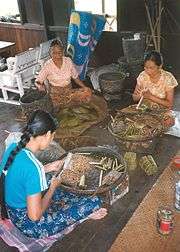Cheroot

The cheroot is a cylindrical cigar with both ends clipped during manufacture. Since cheroots do not taper, they are inexpensive to roll mechanically, and their low cost makes them popular.
The word cheroot comes from French cheroute, from Tamil curuttu/churuttu/shuruttu (சுருட்டு), roll of tobacco. This word could have been absorbed into the French language from Tamil during the 18th century, when the French were trying to stamp their presence in South India. The word could have then been absorbed into English from French.[1]
Asia

Cheroots are traditional in Burma and India, and consequently popular among the British during the days of the British Empire. They are often associated with Burma in literature:
My brother was unlike us in some things, Sahib. He was fond of the sharab called 'Whisky' and of dogs; he drank smoke from the cheroot after the fashion of the Sahib-log and not from the hookah nor the bidi; he wore boots; he struck with the clenched fist when angered; and never did he squat down upon his heels nor sit cross-legged upon the ground. Yet he was true Pathan in many ways during his life, and he died as a Pathan should, concerning his honour (and a woman). Yea—and in his last fight, ere he was hanged, he killed more men with his long Khyber knife, single-handed against a mob, than ever did lone man before with cold steel in fair fight.— Captain Percival Christopher Wren, I.A.R., 1912, Driftwood Spars
Apparently, cheroot smoking was also associated with resistance against tropical disease in India. Verrier Elwin wrote in a foreword (1957) to Leaves from the Jungle: Life in a Gond Village,
A final thing strikes me as I re-read the pages of the Diary that follows is that I seem to have spent much of my time falling ill. I attribute this to the fact that in those days I was a non-smoker. Since I took to the cheroot, I have not had a single attack of malaria, and my health improved enormously in later years."— Leaves from the Jungle: Life in a Gond Village, OUP 1992, p.xxix
Although a cheroot is defined as cylindrical, home-rolled cheroots in Burma are sometimes conical.[3]
See also
References
- ↑ "Etymology of Selected Words of Indian Language Origin". Wmich.edu.
- ↑ Rudyard Kipling, Rudyard. "Barrack-Room Ballads". Mandalay.
- ↑ "Cigars and Cheroots". Travel2photograph.wordpress.com.
External links
| Look up cheroot or stogie in Wiktionary, the free dictionary. |
